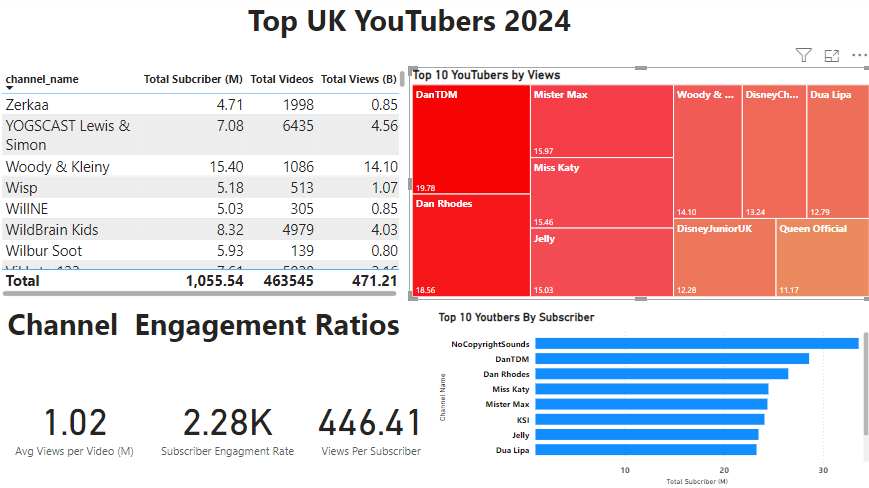Top YouTubers in UK for 2024
Introduction
The dataset provides insights into the top YouTubers in the UK for 2024, focusing on three key metrics: Total Videos, Total Views, and Total Subscribers.
Data Source
The dataset is sourced from Kaggle, but it required significant cleaning and preprocessing.
Tools & Technologies
- Excel: Initial data exploration and cleaning.
- SQL: For data storage, querying, and manipulation.
- Power BI: For creating interactive visualizations and dashboards.
Methodology
- Design: Defined the project objectives, identified relevant metrics, and planned the data workflow.
- Development: Processed and cleaned the raw data, then loaded it into SQL for analysis.
- Testing: Verified data accuracy and ensured that the key metrics aligned with the project goals.
- Analysis: Performed detailed analysis and created visualizations to present insights into the top UK YouTubers of 2024.
SQL Query Process
In this project, I used SQL to clean and query the data effectively. Here’s a breakdown of the steps:
Step 1: Loading the Data
First, I uploaded the raw dataset into an SQL database to make querying easier. This dataset included information about YouTubers such as total videos, total views, total subscribers, and more.
Step 2: Clean the Data
/*
Select the required columns: channel name, total subscribers, total views, and total videos.
Extract the channel name from the 'NOMBRE' column by removing the part after the '@' symbol.
*/
-- 1. Select the necessary columns and clean the channel name
SELECT
SUBSTRING(NOMBRE, 1, CHARINDEX('@', NOMBRE) - 1) AS channel_name, -- Extract channel name before '@'
total_subscribers,
total_views,
total_videos
FROM
top_uk_youtubers_2024;
## Step 2: Clean the Data
```sql
/*
Select the required columns: channel name, total subscribers, total views, and total videos.
Extract the channel name from the 'NOMBRE' column by removing the part after the '@' symbol.
*/
-- 1. Select the necessary columns and clean the channel name
SELECT
SUBSTRING(NOMBRE, 1, CHARINDEX('@', NOMBRE) - 1) AS channel_name, -- Extract channel name before '@'
total_subscribers,
total_views,
total_videos
FROM
top_uk_youtubers_2024;
step 3: Create The SQL View
CREATE VIEW view_Top_youtubers_2024 As
select CAST (SUBSTRING (NOMBRE, 1, CHARINDEX('@', NOMBRE) -1 ) AS varchar(100)) as channel_name,
total_subscribers,
total_views,
total_videos
from youtube_data_from_python
Stpe 4: Data Quality Test
/*
Data quality tests
- The data needs to be 100 records of Youtube channels (row count test) 2.The data needs 4 fields (column count test)
- The channek name column must be string format, and the other columns must be numerical data types (data type check)
- Each record must be unique in the dataset (duplicate count check)
Row count - 100 (pass) Column count - 4
Data types Channel_name = VARCHER total_subscribers = INTGER total_views = INTGER total_video = INTGER
Duplicate count = 0
*/
1.
/*
# Count the total number of records (or rows) are in the SQL view
*/
SELECT
COUNT(*) AS no_of_rows
FROM
view_uk_youtubers_2024;
2. /*
# Count the total number of columns (or fields) are in the SQL view
*/
SELECT
COUNT(*) AS column_count
FROM
INFORMATION_SCHEMA.COLUMNS
WHERE
TABLE_NAME = 'view_uk_youtubers_2024'
3. /*
# Check the data types of each column from the view by checking the INFORMATION SCHEMA view
*/
SELECT
COLUMN_NAME,
DATA_TYPE
FROM
INFORMATION_SCHEMA.COLUMNS
WHERE
TABLE_NAME = 'view_uk_youtubers_2024';
4. /*
# 1. Check for duplicate rows in the view
# 2. Group by the channel name
# 3. Filter for groups with more than one row
*/
-- 1.
SELECT
channel_name,
COUNT(*) AS duplicate_count
FROM
view_uk_youtubers_2024
-- 2.
GROUP BY
channel_name
-- 3.
HAVING
COUNT(*) > 1;
Result

DAX Measures
// Total Subscribers (M)
Total Subscribers (M) =
VAR million = 1000000
VAR sumOfSubscribers = SUM(view_uk_youtubers_2024[total_subscribers])
VAR totalSubscribers = DIVIDE(sumOfSubscribers, million)
RETURN totalSubscribers
// Total Views (B)
Total Views (B) =
VAR billion = 1000000000
VAR sumOfTotalViews = SUM(view_uk_youtubers_2024[total_views])
VAR totalViews = ROUND(sumOfTotalViews / billion, 2)
RETURN totalViews
// Total Videos
Total Videos =
VAR totalVideos = SUM(view_uk_youtubers_2024[total_videos])
RETURN totalVideos
// Average Views Per Video (M)
Average Views per Video (M) =
VAR sumOfTotalViews = SUM(view_uk_youtubers_2024[total_views])
VAR sumOfTotalVideos = SUM(view_uk_youtubers_2024[total_videos])
VAR avgViewsPerVideo = DIVIDE(sumOfTotalViews, sumOfTotalVideos, BLANK())
VAR finalAvgViewsPerVideo = DIVIDE(avgViewsPerVideo, 1000000, BLANK())
RETURN finalAvgViewsPerVideo
// Subscriber Engagement Rate
Subscriber Engagement Rate =
VAR sumOfTotalSubscribers = SUM(view_uk_youtubers_2024[total_subscribers])
VAR sumOfTotalVideos = SUM(view_uk_youtubers_2024[total_videos])
VAR subscriberEngRate = DIVIDE(sumOfTotalSubscribers, sumOfTotalVideos, BLANK())
RETURN subscriberEngRate
// Views Per Subscriber
Views Per Subscriber =
VAR sumOfTotalViews = SUM(view_uk_youtubers_2024[total_views])
VAR sumOfTotalSubscribers = SUM(view_uk_youtubers_2024[total_subscribers])
VAR viewsPerSubscriber = DIVIDE(sumOfTotalViews, sumOfTotalSubscribers, BLANK())
RETURN viewsPerSubscriber